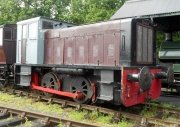Mid-Suffolk Light Railway
- Note: There is a visitor attraction at Brockford Station, Wetheringsett, Stowmarket, Suffolk, IP14 5PW. For more details see their website and additional information below.
General
The Mid-Suffolk Light Railway ran for just 19 miles from Haughley on the Great Eastern Railway line to Laxfield, north of Ipswich. The line became part of the London and North Eastern Railway in 1924 and was closed completely on 26 July 1952. The Railway is now a preservation society run by a small but dedicated of volunteers. The Mid-Suffolk Light Railway is the only steam preservation railway in Suffolk. [1]
1900 The company was incorporated under the Light Railways Act of 1896.
1908 The line is to be 42 miles in length, and is currently under construction. [2]
The line was intended to run from Haughley to Halesworth, with a second branch running from Kenton station to Westerfield near Ipswich. The Mid-Suffolk Light Railway, or Middy as it became affectionatley known, was built to provide transport to the rural Suffolk communities who had no reliable transport links. It was built in accordance with the 1896 Light Railways Act, which allowed for cheaper construction methods in return for a speed restriction of 25 mph. The railway was built as cheaply as possible: the buildings were constructed using corrugated iron, and the route followed the natural contours of the land to minimise the need for embankments and bridges.
The railway was built too late, long after the great railway boom that had affected the country in the Victorian age, and soon came into financial difficulties. The planned railway had troubles from the very beginning, having disputes with the neighbouring Great Eastern Railway (GER) and local landowners. The railway was bankrupt before it opened. It was pure determination that kept the Middy running. The Railway opened to freight traffic in 1905 with the hope that this would bring in enough income to complete the line, but by 1908, although the line was making an income, it still was not enough to cover its original debts and for work to continue. Finally on Tuesday 29 September 1908 the line was opened to passengers with two trains in either direction on weekdays, but this failed to bring great trade as many of the stations were sited miles from the communities they were meant to serve.
In 1924 the Middy lost its independence and was grouped together with the London and North Eastern Railway (LNER), but apart from a new replacement of second-hand rolling stock the railway continued as it always had done. The railway's original locomotives were scrapped and replaced by 0-6-0 "Blackwall Tanks" (classified J65) which were eventually replaced by the older but stronger GER Class Y14 (classified J15 by the LNER).
The passenger traffic began to decline over the next couple of decades as more people were buying motorcars and more and more goods traffic was also going by road. This all changed with the beginning of the Second World War. With petrol rationing, the Middy became an important transport link and with US airbases built near the Mendlesham and Horham stations, the line was relied upon for transporting military equipment and regularly used by American serviceman. The war brought more traffic to the line – both goods and passengers – as the railway became important in helping the war effort. This all came at a cost to the railway. No effort was made to maintain the rolling stock or the line itself, like the rest of Britain's railway network.
After the war the Middy entered into the ownership of British Railways in 1948. Although business was dwindling and the line was in a state of neglect and decay after being exhausted during WW2, the line became an attraction for enthusiasts and railway management due to the picturesque landscape through which the railway ran; and its informal atmosphere. The end of the war meant a surplus of ex-army lorries which took away the agricultural business, the main source of income for the line. The Middy eventually closed in 1952, 40 years after it had unsuccessfully opened.
Heritage Railway
Brockford Station, Wetheringsett, Stowmarket, Suffolk, IP14 5PW.
- Nearly 40 years after it closed, a group of enthusiasts formed a Company to recreate the Middy on the site of Brockford Station, now the corner of a large field.
- The Mid-Suffolk Light Railway Society had an ambitious task ahead of them due to the temporary nature of the original line. As far as is known, no coaches or locomotives of the Middy are still in existence and the corrugated iron buildings were either left to rust or sold to become farm sheds. However, the Company has been recreating typical scenes from the Middy's past by using restored coaches and wagons that would have run on its bigger neighbour, the Great Eastern Railway, and its successor, the London & North Eastern Railway. The Society has been able to collect a number of Great Eastern coaches, one of which is in working order, with many more under restoration. The museum has also been able to collect the remaining station buildings from former Middy railway stations.
- The museum currently has three locomotives, two steam, one diesel:
- Andrew Barclay 0-4-0ST "Little Barford" – operational
- Hudswell, Clarke and Co 0-6-0ST "Alston" – under restoration
- Ruston 0-4-0DM diesel-mechanical
- The museum operates from April to the end of September on Sundays and Bank Holidays, with Santa specials in December. Most of the Open Days have a Special Event to accompany the running of the steam locomotive and the Middy is one of the few working steam museums where it is possible to ride in the guards van.



